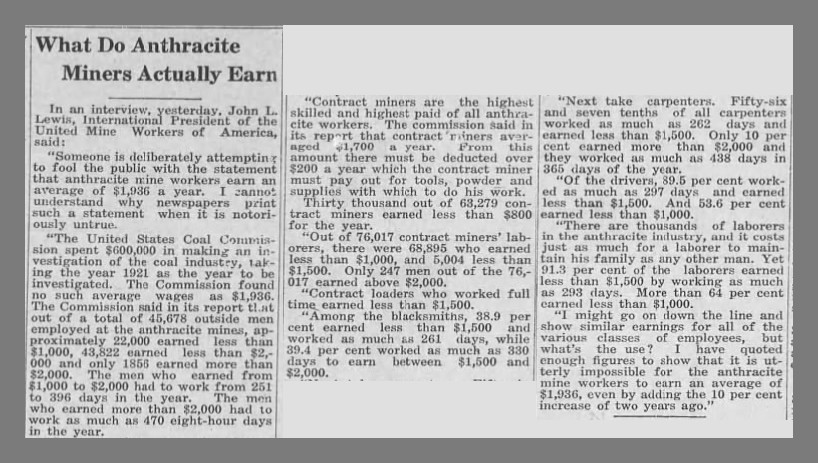
In an interview given on September 4, 1925, John L. Lewis, International President of the United Mine Workers of America, commented on a report that anthracite mine workers earned an average of $1,936 a year. Statements from the interview were printed in the Lykens Standard, September 4, 1925.
For the purposes of comparison, $1,936 had the same purchasing power as about $35,707 today. [See: U. S. Bureau of Labor Statistics, Inflation Calculator].
John L. Lewis‘ statements:
Someone is deliberately attempting to fool the public with the statement that anthracite mine workers earn an average of $1,936 a year. I cannot understand why newspapers print such a statement when it is notoriously untrue.
The United States Coal Commission spent $600,000 in making an investigation of the coal industry taking the year 1921 as the year to be investigagted. The Commission found no such average wages as $1,936. The Commission said in its report that oujt of a total of 45,678 outside men employed at the anthracite mines, approximately 22,000 earned less than $1,000, 43,822 earned less tha $2000, and only 1856 earned more than $2,000. The men who earned from $1,000 to $2,000 had to work from 251 to 396 days in the year. The men who earned more than $2,000 had to work as much as 470 eight-hour days in the year.
Contract miners are the highest skilled and highest paid of all anthracite workers. The commission said in its report that contract miners averaged $1,700 a year. From this amout there must be deducted over $200 a year which the contract miner must pay out for tools, powder and supplies with which t do his work.
Thirty thousand out of 63,279 contract miners earned less than $800 for the year.
Out of 76,017 contract miners’ laborers, there were 68,895 who earned less than $1,000, and 5,004 less than $1,500. Only 247 men out of the 76,017 earned above $2,000.
Contract loaders who worked full time earned less than $1,500.
Among the blacksmiths, 38.9 percent earned less than $1,500 and worked as much as 261 days, while 39.4 percent worked as much as 330 days to earn between $1,500 and $2,000
Next take carpenters. Fifty-six and seven tenths of all carpenters worked as much as 262 days and earned less than $1,500. Only ten per cent earned more than $2,000 and they worked as much as 438 days in 365 days of the year.
Of the drivers, 89.5 percent worked as much as 297 days and earned less than $1,500. And 53.6 percent earled less than $1,000.
There are thousands of laborers in the anthracite industry, and it costs just as much for a laborer to maintain his family as any other man. Yet 91.3 percent of the laborers earned less than $1,500 by working as much as 293 days. More that 64 percent earned less than $1,000.
I might go on down the line and show similar earnings for all of the various classes of employees, but what’s the use? I have quoted enough figures to show that it is utterly impossible for the anthracite mine workers to earn an average of $1,936, even by adding the 10 percent increase of two years ago.
____________________________________
News article from Newspapers.com.
Corrections and additional information should be added as comments to this post.